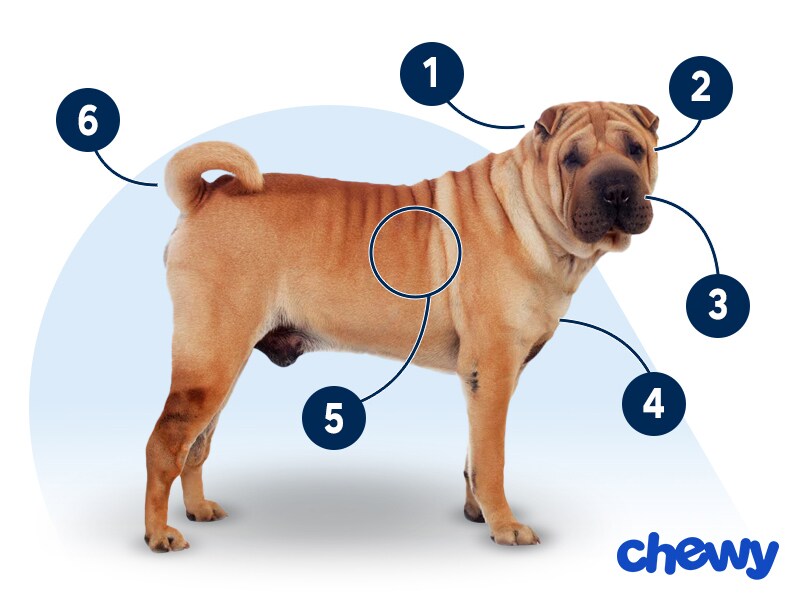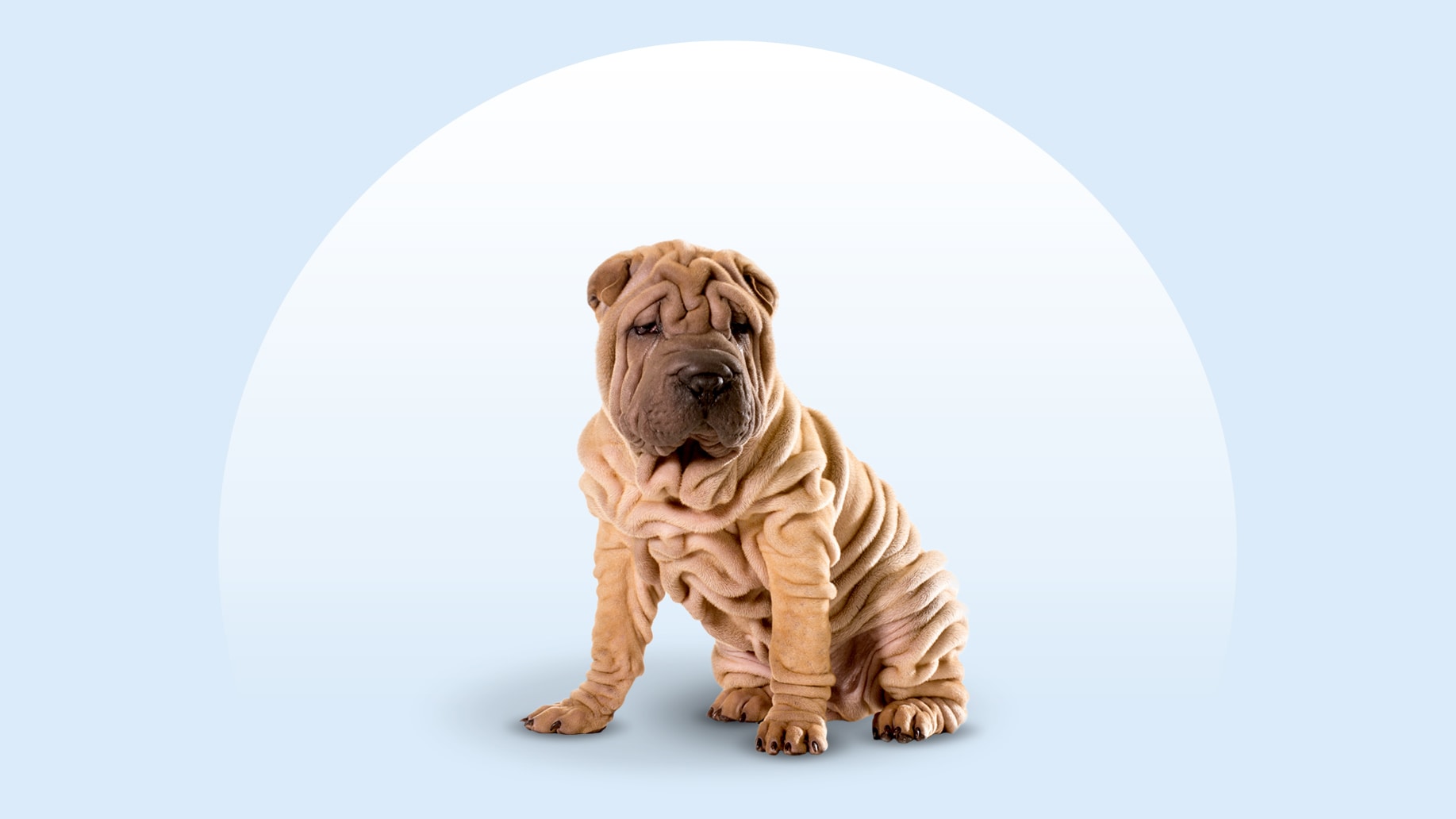Chinese Shar-Pei
Updated October 22, 2025
Chinese Shar-Pei
Updated October 22, 2025
With their unique appearance, the kind and calm Chinese Shar-Pei stands out in a crowd. They may be reserved (especially around strangers), but they’re exceptionally loyal and loving to their favorite person (that’s you, of course).
Aloof, Introverted, Serene
45–60 pounds
18–20 inches
8–12 years
Apricot Dilute, Black, Blue Dilute, Lilac Dilute, Cream, Cream Dilute, Brown, Chocolate Dilute, Red, Five Point Red Dilute, Red Fawn, Fawn, Isabella Dilute, Black Sable, Cream Sable, Fawn Sable, Red Sable, Blue
No, your dog isn’t melting. You just have a Chinese Shar-Pei, and they sometimes look like someone dropped their ice cream cone on a hot summer day.
But all those ripples are just adorably wrinkled fur—and they give your bestie a sorrowful-but-squeezable air. Just don’t squeeze too much; these introverted cuties prefer to initiate the love themselves.
These loyal, reserved pups like to do their own thing, and while they have zero interest in being the life of the party, they’re confident, laid-back dogs who crave a bit of serenity in life.
Chinese Shar-Pei Characteristics
Chinese Shar-Pei Appearance
Chinese Shar-Pei have expressive, sunken eyes and adorably wrinkly skin. They carry their compact body with confidence and bravery.
Like the Chow Chow, Shar-Pei dogs have a blue-black tongue. They also have a curled tail they like to hold high.

- Ears
The Shar-Pei's ears are small and shaped like rounded triangles. They lie flat against the head but are always on alert for unusual sounds.
- Eyes
Their dark eyes sit deep into their wrinkled faces. Depending on their coat color, some Shar-Pei may have lighter-colored eyes.
- Nose
The Shar-Pei’s snout is often said to be shaped like a hippopotamus’. Their nose is large and typically a dark color. However, some may have a nose the same color as their fur.
- Coat Length
The Shar-Pei’s wrinkled coat feels a little rougher than it looks; it’s usually about an inch thick.
- Coat Color
A Shar-Pei dog can come in many different colors and markings. They might be a solid blue (which looks gray), black, brown, cream, fawn, or red—all often with darker shading on their back or ear—or even a solid white. Or they may have a sable coat, which is a lacing of black over a lighter base color, in a variety of shades.
- Tail
The Chinese Shar-Pei has a small tail that’s thicker at the base and tapers at the end. Their tail is set high, and they carry it proudly, curling over either side of their back.
Chinese Shar-Pei Temperament
The Shar-Pei isn’t necessarily a wallflower, because they usually have plenty of confidence. But they also have no interest in being the center of attention.
As independent dogs, they prefer to do their own thing. Affection will probably arrive on their own terms; Shar-Pei will stop by to offer a mushy lick to your hand or cheek, but if you try to snuggle, they won’t always be down for it.
But that doesn’t mean they don’t love you. In fact, Chinese Shar-Pei are hopelessly loyal to their family (and to one favorite person, in particular). They’re also grateful for your attention and care—just look at that tail wag when you offer them a new toy.
While Shar-Pei dogs aren’t star athletes, they will enjoy some sporty activities. Make sure they have a good balance of activity and calm.
How to Care for a Chinese Shar-Pei
The Shar-Pei needs socialization early in life to be a well-adjusted, happy dog. While they may be higher maintenance in their socialization needs, many have low-maintenance coats that don’t call for much brushing.
Grooming
Training
Diet
Exercise
Environment
Chinese Shar-Pei Health
The average Shar-Pei lifespan is 8–12 years. Unfortunately, they can be susceptible to a number of health issues, so pet insurance is a very good idea for this breed.
- Corneal ulcers: Corneal ulcers are very painful for dogs; depending on the severity, they can be treated with an oral antibiotic, an antibiotic ointment, or surgery. If you notice squinting, red eyes, cloudy eyes, or swelling—or if your pet is pawing at or rubbing their eyes—see your vet.
- Dry eye syndrome: Keratoconjunctivitis sicca is when a dog doesn’t produce enough tears for their eyes. This can lead to red, irritated, and inflamed eyes, and you’ll need to see your vet ASAP for treatment options.
- Ear infections: The Shar-Pei’s ears are very small, making them more prone to infections. Your veterinarian may recommend weekly ear cleanings with a medicated ear cleanser to help prevent infections from occurring.
- Entropion: Entropion is an eyelid abnormality in which a dog’s eyelid rolls in on itself, potentially causing pain, eye infections, and ulcers. Surgery is an option for severe cases.
- Glaucoma: Glaucoma occurs when fluid in the eyes doesn’t drain and pressure builds behind the eye. It’s painful and can result in blindness, so it’s a medical emergency. Treatment involves topical medications or surgery.
- Hypothyroidism: Common in this breed (as many as one in five Shar-Pei dogs might experience it), hypothyroidism includes symptoms like lethargy, hair loss, skin and ear infections, and weight gain. A blood test can diagnosis it, and treatment is a daily oral medication.
- Interdigital cysts: This is when the webbing between a dog’s toes becomes inflamed and infected. You’ll notice that the skin is red or that there are small, fluid-filled cysts. It’s very painful for your pup and often causes limping and excessive licking. Treatment may include a variety of medications, laser removal, or surgery.
- Pododermatitis: This is a common condition where dogs excessively lick or chew their paws. Pododermatitis in dogs can occur due to many different underlying medical conditions and can become very painful if untreated.
- Progressive retinal atrophy (PRA): PRA leads to blindness in dogs, and while there is no cure, pups who lose their eyesight tend to adapt well and can still live full, happy lives.
- SARDS: Sudden acquired retinal degeneration syndrome, or SARDS, is a type of PRA that occurs over hours or days, leading to blindness.
- Shar-Pei fever: Shar-Pei fever is an immunoreactive disorder causing a high fever and severe ankle swelling in the back legs. It can lead to liver and kidney failure if left untreated.
- If your dog also has fever, loss of appetite, and a hunched posture, among other symptoms, see a vet right away. There is no cure, but it might not be too late for treatment to manage symptoms.
- Skin infections: A Shar-Pei’s charming folds can trap bits of food, saliva, dirt, and moisture. Bacteria and yeast can multiply there, leading to skin infections. Keep them at bay by cleaning your dog’s folds every day, and monitor for signs of infection, like itchiness, bumps, scabs, irritation, redness, or swollen skin.
Chinese Shar-Pei History
Some say the Chinese Shar-Pei can be traced back to the Han Dynasty more than 2,000 years ago, as some figurines from around 200 B.C.E. resemble the wrinkly dogs. But there’s lots of speculation, and some say the pups were companions and guardian dogs for royal families, while others say they belonged to peasants who used them to hunt and herd.
When the Chinese Communist Party came to power in 1949, dogs were banned, and this almost led to the Shar-Pei’s extinction.
However, a breeder in Hong Kong named Matgo Law was so worried about the breed’s future, he advocated to save them. His persistence helped increase the dog’s popularity in the United States, according to the Chinese Shar-Pei Club of America. The American Kennel Club first recognized the Chinese Shar-Pei in 1992.
Shar-Pei cost between $1,000–$3,000 on average. If you choose this route, pick a responsible breeder.
You can also consider Shar-Pei adoption via a Shar-Pei rescue like Pei People. Or, keep an eye out at your local shelter or Search Chewy’s database of adoptable dogs in your area.








